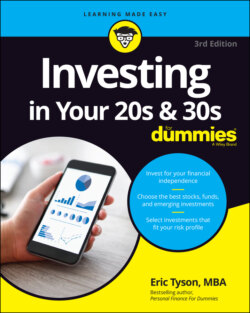Читать книгу Investing in Your 20s & 30s For Dummies - Eric Tyson - Страница 20
Realizing risks
ОглавлениеThe investments that you expect to produce higher returns (such as stocks) fluctuate more in value, particularly in the short term. However, if you attempt to avoid all the risks involved in investing, you probably won’t succeed, and you likely won’t be happy with your investment results and lifestyle. In the investment world, some people don’t go near stocks or real estate that they perceive to be volatile, for example. As a result, such investors often end up with lousy long-term returns and expose themselves to some high risks that they overlooked, such as the risk of inflation and taxes eroding the purchasing power of their money.
You can’t live without taking risks. Risk-free activities or ways of living don’t exist. You can sensibly minimize risks, but you can never eliminate them. Some methods of risk reduction aren’t palatable because they reduce your quality of life.
Risks are also composed of several factors. Following are the major types of investment risks and a few of the methods you can use to reduce these risks while not missing out on the upside that investments offer:
Market-value risk: Although stocks can help you build wealth, they can also drop 20 percent or more in a relatively short period of time. Entering 2020, who was thinking about how a pandemic and the government’s response might impact stock prices? Then, in a few weeks, stocks slid more than 30 percent due to government-mandated economic shutdowns. Although real estate, like stocks, has been a rewarding long-term investment, various real estate markets get clobbered from time to time.
Individual-investment risk: A down market can put an entire investment market on a roller-coaster ride, but healthy markets also have their share of individual losers. Just as individual stock prices can plummet, so can individual real estate property prices. With lending investments, you have a claim on a specific amount of a currency. Occasionally, currencies falter. Most folks ignore this low frequency but very high impact risk when thinking about lending investments.
Purchasing-power risk: Inflation — which is an increase in the cost of living — can erode the value of your money and its purchasing power (what you can buy with that money). I often see skittish investors keep their money in bonds and money market accounts, thinking that they’re playing it safe. The risk in this strategy is that your money won’t grow enough over the years for you to accomplish your financial goals. In other words, the lower the return you earn, the more you need to save to reach a financial goal. As a younger investor with so many years and decades of investing in your future, you need to pay the most attention to the risk of generating low returns.
Liquidity risk: Some investments are more liquid (how quickly an investment can be converted to cash) than others and more readily sold at fair market value on short notice. Bank savings accounts have no real liquidity risk. A real estate investment, by contrast, takes time and money to sell, and if you must sell most real estate quickly, you’ll likely get a fair amount less than its current full market value.
Career risk: In your 20s and 30s, your ability to earn money is probably your biggest asset. Education is a lifelong process. If you don’t periodically invest in your education, you risk losing your competitive edge. Your skills and perspectives can become dated and obsolete. Although that doesn’t mean you should work 80 hours a week and never do anything fun, it does mean that part of your “work” time should involve upgrading your skills.
